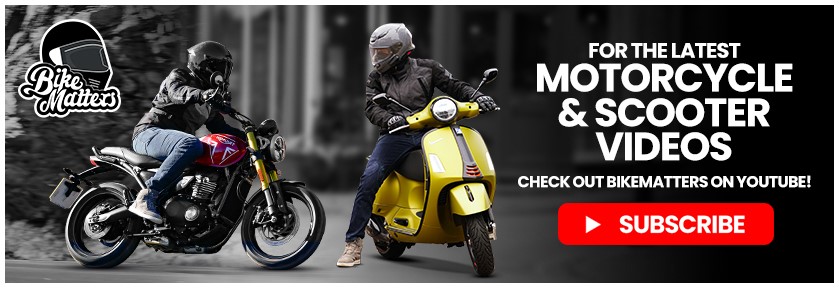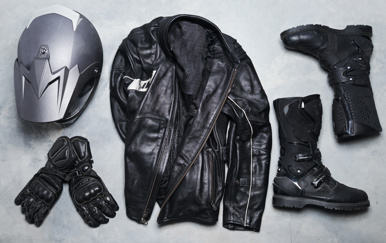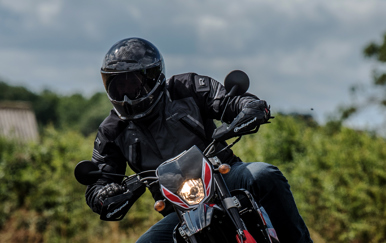Legally, a helmet is one of the only pieces of equipment you have to wear while riding your motorcycle in the UK. Wearing a helmet isn’t going to prevent you from crashing, but it can protect you from serious injuries.
A good motorcycle helmet can also improve your riding experience significantly, shielding you from the weather and reducing rider fatigue. No matter your price point, there will always be something on the market that’s perfect for you.
How do motorcycle helmets work?

Whether you’re new to the biking world or a seasoned rider, it’s always helpful knowing how your gear can keep you safe.
There are four main components of the helmet that work together to provide you with protection:
- Outer shell: Made from fibre-reinforced composites or thermoplastics, the outer shell will dispense energy from the impact to lessen the force.
- Impact absorbing liner: The liner of the helmet is made from expanded polystyrene and helps to cushion and absorb shock.
- Comfort padding: The soft foam and cloth layer that sits next to your head not only helps keep you comfortable but also provides a snug fit - so you know that your helmet isn't going anywhere.
- Retention strap: Typically known as the chin strap, this helps to keep the helmet on your head during a crash.
What helmets are legal in the UK?
There are several UK safety standards for motorcycle helmets, to ensure your helmet can protect you in the event of an accident. A key one is the Economic Commission for Europe standard, known as the ECE 22.05/06.
This standard is mandatory for all helmets across the UK and Europe to ensure they provide high levels of protection in different situations. The standard was recently updated to ECE 22.06, but the ECE 22.05 is still a valid safety rating.
You can verify that a helmet meets the required safety and quality standards for the UK if you can see the BSI Kitemark, which signifies it has been independently tested by experts.
What is DOT, ECE 22.06 and ACU Gold?
Other important safety standards to take note of are ACU Gold and DOT. ACU Gold is a UK certification for helmets that have passed additional safety tests to make them suitable for competitive racing. This standard isn’t necessary for road use, but important when it comes to track usage.
Meanwhile, DOT is an American safety classification you may come across when looking at helmets. Legally, you cannot ride on the road with a DOT helmet in the UK, although that doesn’t stop some retailers from selling them – so be aware!
How do I know if my goggles and visors are legal in the UK?
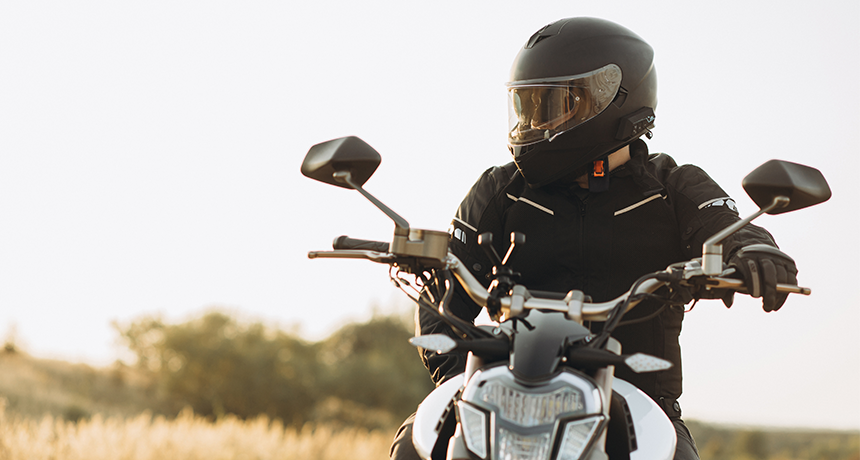
According to the UK Government, if you ride with a visor or goggles they must either:
- Meet a British Standard and display a BSI Kitemark
- Meet a European standard offering at least the same safety and protection as the British Standard and carry a mark equivalent to the BSI Kitemark (UNECE Regulation 22.05)
However, if you’re buying a certified helmet in the UK that comes with a visor, this should already meet regulations.
Learn more about the legal requirements of motorcycle gear.
What style of motorcycle helmet should I choose?
When it comes to choosing a motorcycle helmet, the options can be overwhelming. However, it can help to narrow it down to a style that works for you. To help you make your choice, we've summed up the key helmet models below:
Open Face Helmets

As the OG protective helmet, the open-face is considered a classic for custom or retro riders. This option may seem perfect for getting the wind in your hair, but that feeling of freedom may be short lived – with dust and bugs likely to hit your face as you ride along.
While some open-face helmets do come with a built-in visor, others will require you to invest in separate goggles or a visor. If this is your helmet of choice, it’s important to make sure you have some kind of eye protection in place.
Although this helmet can be a favourite in the warmer months, it offers no protection to your chin and jawline, leaving you vulnerable in the event of a crash.
Pros
-
Good ventilation.
-
Provides a wide field of vision.
-
Goes with a retro loo.
Cons
-
No protection for your chin and jawline.
-
You're more exposed to the elements.
Full Face Helmet
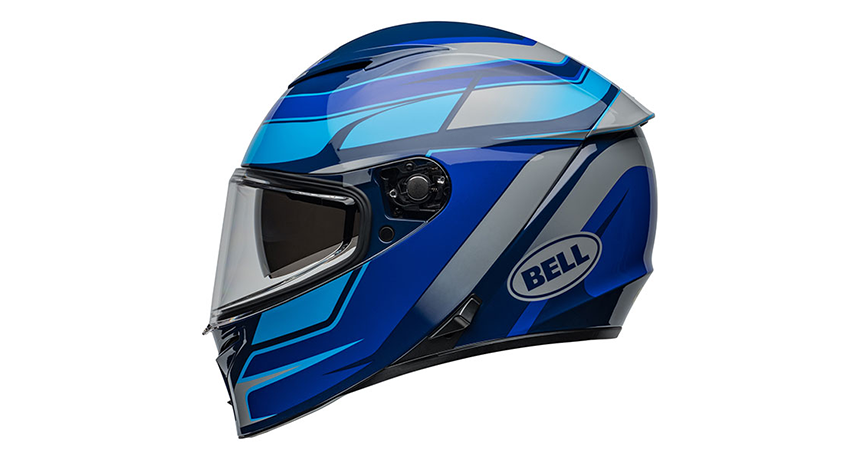
Undeniably the best all-rounders, a full-face helmet is ideal for all weather conditions and offers protection against the widest range of impact points. These helmets provide a safe solution for every type of riding, with chin and jaw protection designed to take some of the impact in the event of a crash.
However, if you’re someone who hates that ‘packed in’ feeling, these helmets may leave you feeling more than a little claustrophobic. Wider versions of a full-face helmet are available in the shape of motocross and adventure-style helmets.
Pros
-
Considered to be the safest type of helmet.
-
Offers protection from the weather.
Cons
-
Can feel claustrophobic.
-
If you wear glasses, make sure to check compatibility with your helmet of choice before buying.
Motocross/Adventure Style Helmet

You can usually spot a motocross or adventure-style helmet by its high peak and elongated chin bar (designed to maximise airflow). With no visor, these helmets are designed to be worn with goggles to give the rider that wind-in-your-face feeling – but in a safer way.
Adventure-style helmets are a great option if you’re frequently taking your bike off-road, but if you’re likely to spend a lot of time in traffic you may prefer a dual-sport helmet. These models retain the cool MX style and functionality while also offering padding and full-face visors – making them better suited for road use.
Pros
-
Better for off-road.
-
Offers better sun protection than other helmets.
Cons
-
Noisier than a full-face helmet.
-
The peak on some helmets can cause drag.
Flip up/Modular Helmet
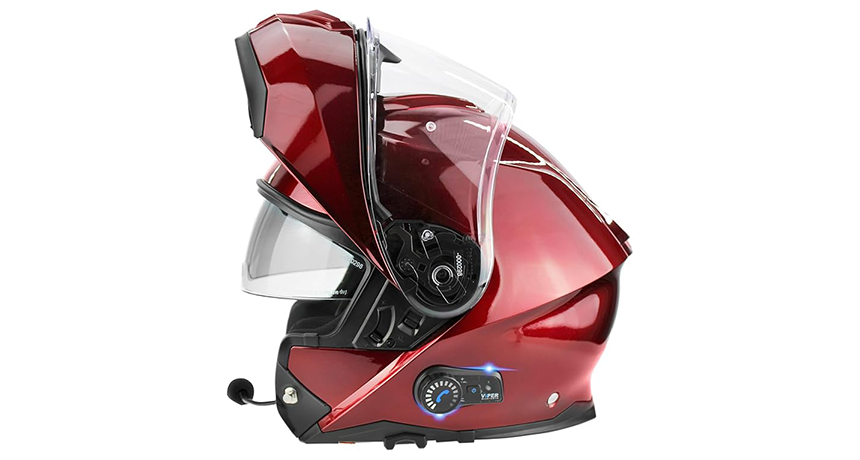 If you feel like a full-face helmet is too claustrophobic for you but want a good level of protection, a flip up helmet may be an ideal compromise. These helmets are largely the same as a full-face, but the chin guard and visor are hinged to (you guessed it) flip up.
If you feel like a full-face helmet is too claustrophobic for you but want a good level of protection, a flip up helmet may be an ideal compromise. These helmets are largely the same as a full-face, but the chin guard and visor are hinged to (you guessed it) flip up.
Boasting all of the capabilities of a full-faced helmet while also offering the ability to be in open-face mode, these helmets are hugely popular for touring and commuting. The straightforward mechanism makes it easier for riders to talk to people with the helmet on, and lets you keep your glasses on.
Pros
-
Easier to put on and take off.
-
Well-suited to urban riders.
Cons
-
Heavier than a full-face helmet
-
May be less aerodynamic.
What is the best motorcycle helmet (for you)?

Getting the right fit
When it comes to buying a motorcycle helmet, getting the right fit is crucial.
A helmet that’s too small can cause discomfort that makes it hard to concentrate on riding and can even cause headaches, while a too-big helmet will not fit snugly against your head – reducing its effectiveness in the event of a crash.
If you’re not sure how to find the right fit, we recommend following the guidelines laid out by SHARP, the helmet safety scheme (outlined below) or going to a reputable motorcycle helmet supplier for a fitting.
- Get measured: Before trying on any helmets, you need to know your exact head size. Measure around your head just above the ears and take a measurement at the forehead.
- Try it on: Once you've found a helmet you like, place it firmly on your head and secure the chin strap. Once on, you should be able to feel it against the whole of your head, without any pressure points. Keep it on for a few minutes to make sure it's comfortable.
- Check the fit: Try rotating the helmet from side to side. If you're wearing a full face helmet, your cheeks should follow its movement while comfortably and firmly remaining in contact with the cheek pads. If the helmet moves or slips, it's probably the wrong size.
- Will it stay on? Ask someone to try and roll the helmet off your head by carefully pushing up from the rear of the helmet at its base. If you can roll it off in the showroom, it's sure to come off in a crash.
How much should you spend on a motorcycle helmet?
With motorcycle helmets available at many different price points, it can be hard to know what the ‘right’ price is.
It’s important to remember that all helmets have to pass a minimum safety standard, which means it ultimately comes down to how much you want to pay and what your priorities are.
Many cheaper models often have an Acrylonitrile Butadiene Styrene (ABS, a type of thermoplastic) or polycarbonate shell, which makes them more vulnerable to degradation (typically from fuel) and means they can’t be painted.
If customisation is your cup of tea, you might want to for a helmet material that can be painted – such as carbon fibre or fiberglass. These materials are more expensive (meaning a higher price point) but will be more durable and comfortable.
Best motorbike helmets for 2025
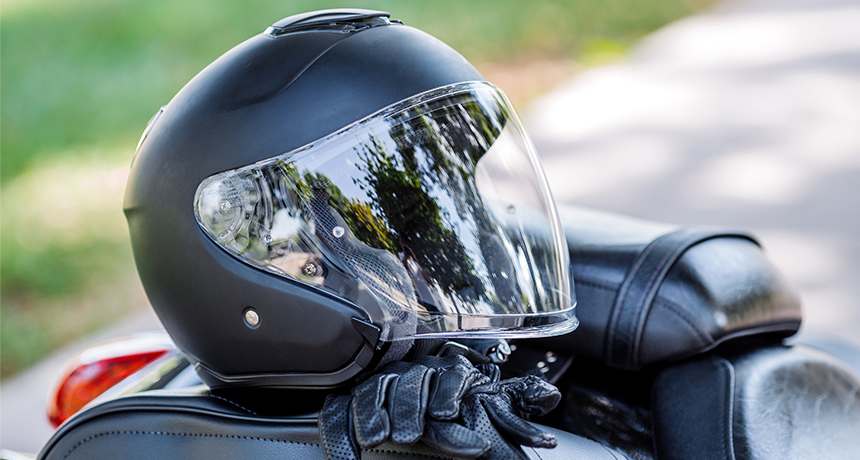
Best open face helmets
Premium-priced option - Shoei J-Cruise III: With a large panoramic visor and high-performance ventilation system, the Shoei J-Cruise III is a great option for urban riding and touring.
Price: £549.99.
Medium-priced option - LS2 Infinity 2: Boasting two upper air inlets, the LS2 Infinity II offers maximum ventilation for driving on city roads and highways.
Price: £199.99.
Low-priced option - Caberg Riviera V4X: This compact, demi jet helmet from Italian manufacturer Caberg is ideal for urban use
Price: £79.99 (RRP £99.99)
Best full face helmets
Premium-priced option - AGV Legends X3000: Lightweight and stylish, the X3000 is a great example of a full-face retro helmet.
Price: £329.99.
Medium-priced option - Shoei ex-zero: Taking inspiration from the Shoei ex series released in the 80’s, this helmet offers a classic off-road look while taking safety into priority.
Price: £279.99 (RRP: 279.99).
Low-priced option - Bell Moto-3: A true trailblazer, the iconic retro design of this helmet has been mimicked by many.
Price: £249.99.
Best Motocross Helmets and Adventure Helmets
Premium-priced option - Arai Tour X5: This helmet is ideal for the off-road rider, offering a firm fit, excellent ventilation and a redesigned nose deflector to make the use of goggles as easy as possible.
Price: £599.99.
Medium-priced option - Scorpion ADF-9000: Designed to meet the needs of serious adventure riders, the Scorpion ADF-9000 features an ultrawide Max Vision Pinlock visor and emergency quick-release cheek pads.
Price: £299.99.
Low-priced option - Bell MX-9 Adventure MIPS: A great choice for both on and off-road riding, this helmet is designed to adapt to your needs.
Price: £149.99 (RRP: £219.99)
Best retro style motorcycle helmets
Premium-priced option - AGV Legends X3000: Lightweight and stylish, the X3000 is a great example of a full-face retro helmet.
Price: £329.99.
Medium-priced option - Shoei ex-zero: Taking inspiration from the Shoei ex series released in the 80’s, this helmet offers a classic off-road look while taking safety into priority.
Price: £279.99 (RRP: 279.99).
Low-priced option - Bell Moto-3: A true trailblazer, the iconic retro design of this helmet has been mimicked by many.
Price: £249.99.
Best flip up/modular motorcycle helmets
Premium-priced option - Shoei Neotec 3: With an innovative flip-up mechanism, this is a great versatile option.
Price: £599.99.
Medium-priced option – HJC RPHA 91 Carbon: Aerodynamic and lightweight, the RPHA 91 Carbon is the modular touring helmet designed for all-day comfort.
Price: £367.10 (RRP: £599.99)
Low-priced option - LS2 Advant X: Light and resistant, the Advant X is a great option for any type of riding and for all weather conditions.
Price: £299.99.
Can I buy a second-hand helmet?
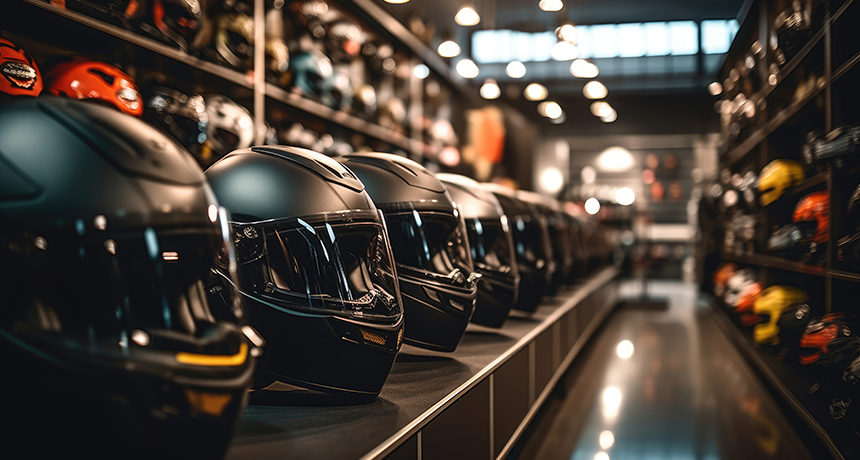
If you’re trying to cut down on costs, buying a second-hand helmet may seem like a tempting option. However, most experts don’t recommend it.
A second-hand helmet could be overused or have been damaged in an accident, meaning it won’t protect you properly in the event of a crash.
Helmets can also hold onto the sweat and bacteria of a previous owner (gross!) Truth is you’ll never truly know what the condition the helmet will be in, especially internally so buying a used helmet is best avoided!
Do helmets expire?
Unfortunately, yes. Manufacturers recommend replacing your helmet every seven years from the date of production, or every three years if you wear it daily.
This is because the liner inside the helmet breaks down over time due to sweat and oil, reducing its protection. Using an expired helmet increases your risk of injury in the event of an accident, even if it still looks to be in good condition.
What should I do with my old helmet?
Just bought a shiny new helmet? There are plenty of things you can do with your old one:
- Donate it to the emergency services.
- Trade it in – some motorcycle shops will offer you a discount on a new helmet.
- Fancy dress – if you’ve got any fancy dress parties coming up, why not go as the STIG?
- Display it!
Motorcycle helmet maintenance
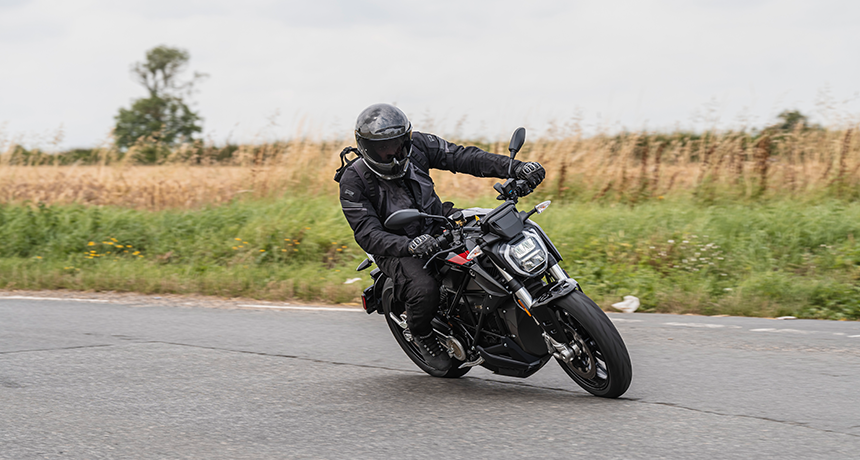
Do:
- Remove the interior liner to wash by hand or in the washing machine on a gentle heat (follow guidance for this)
- Wash the outside of the helmet with mild soap and warm water.
- Use specialised visor cleaners or wipes to avoid damaging the coatings.
Don't
- Use strong detergents or bleach - they can damage the helmet.
- Store it near heat while drying, because this can cause the glue to weaken.
- Scrub too hard, as this may damage the surface of the helmet.
The last stop!
If you found this guide helpful, we have plenty more gear-related guides on offer!
From the best motorcycle riding gear for beginners to our commuting must-haves, we’re here to make sure you have everything you need to feel confident on your bike.

